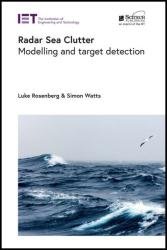Radar Sea Clutter: Modelling and target detection
- Добавил: literator
- Дата: 2-01-2022, 04:00
- Комментариев: 0
 Название: Radar Sea Clutter: Modelling and target detection
Название: Radar Sea Clutter: Modelling and target detectionАвтор: Luke Rosenberg, Simon Watts
Издательство: Scitech Publishing
Год: 2022
Страниц: 382
Язык: английский
Формат: pdf (true), epub
Размер: 25.1 MB
The first maritime surveillance radars in World War II quickly discovered that returns from the sea, soon to be known as sea clutter, were often the limiting factor when attempting to detect small targets while controlling false alarms. This remains true for modern radars, where the detection of small, slow moving targets on a rough sea surface remains one of the main drivers for maritime radar design, particularly in the development of detection processing.
The design, development and testing of radar signal processing for maritime surveillance requires a very detailed understanding of the characteristics of radar sea clutter and of the combined target and clutter returns. This book provides an updated and comprehensive review of the latest research into radar sea clutter and detection methods for targets in sea clutter. The emphasis is on understanding the characteristics of radar sea clutter as observed with different radars, viewing geometries and environmental conditions. This understanding is assisted by the development of mathematical models that are used in the radar design process.
In recent years there has been an increased interest in operating at higher altitudes, resulting in the sea surface being illuminated with larger grazing angles than used in traditional airborne surveillance platforms or ground-based systems. There has also been significant research into bistatic operation, including passive radars using illuminators of opportunity. The use of coherent and multi-aperture systems in maritime radar are also of increasing interest and these new application areas are also covered in this book.
Maritime surveillance radars can be ground, air or space based. For ground-based radar systems, the most common are navigation radars that monitor the coastline, or on naval ships providing situational awareness. The radars on military ships are typically more advanced and used for multiple applications ranging from navigation to air defence. All these radars generally operate at S- or X-band frequencies and scan either mechanically or electronically to provide 360° coverage. These radars may typically be 20–30 m above the sea surface, resulting in low grazing angles over most of the surveyed sea surface. This can result in lower backscatter and spikier amplitude statistics compared with higher grazing angles, complicating the detection of slow moving small targets.
Airborne maritime surveillance radars are primarily concerned with the detection of targets on the sea surface. These radars may be used in military applications, such as anti-submarine warfare and surface surveillance of shipping, or in paramilitary or civil applications, looking for smugglers or refugee boats. They are typically X-band radars scanning over 360° but may also include radars on fast jets with forward looking antennas or fixed side looking radars, suitable for radar imaging. When attempting to detect small stationary and slow moving targets on the sea surface, airborne radars have traditionally operated at low altitudes, typically below 3,000 ft (914 m). This is because of the higher signal-to-clutter power ratio that results from operation at low grazing angles. However, there is a push for current and future airborne platforms, including unmanned aerial systems (UASs), to operate at higher altitudes. This extends the radar horizon and provides a much larger surveillance region. The consequence is that the grazing angle also increases, particularly for close-in ranges, and the strength of the sea clutter increases, making the detection of small targets difficult. Two example maritime platforms include the P-8A Poseidon and MQ-4C Triton UAS.
Скачать Radar Sea Clutter: Modelling and target detection
Внимание
Уважаемый посетитель, Вы зашли на сайт как незарегистрированный пользователь.
Мы рекомендуем Вам зарегистрироваться либо войти на сайт под своим именем.
Уважаемый посетитель, Вы зашли на сайт как незарегистрированный пользователь.
Мы рекомендуем Вам зарегистрироваться либо войти на сайт под своим именем.
Информация
Посетители, находящиеся в группе Гости, не могут оставлять комментарии к данной публикации.
Посетители, находящиеся в группе Гости, не могут оставлять комментарии к данной публикации.
